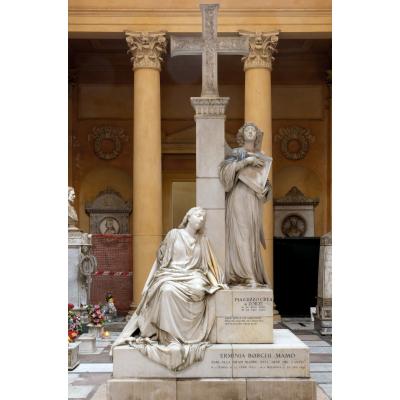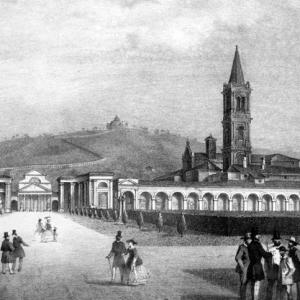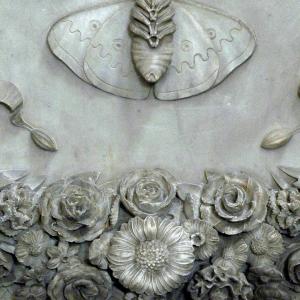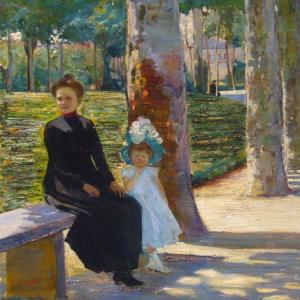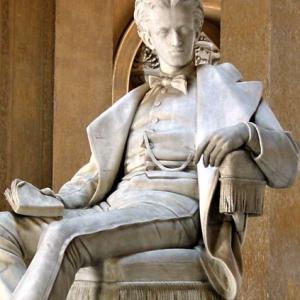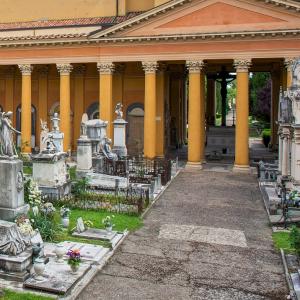Schede
The monument, signed and dated 1894, is located in one of the most evocative areas of the monumental cemetery: the Angel Gallery. This is one of the architectures most loved by visitors, a distinctive, distinguishing and special area of Certosa. It is undeniable that this is possible because many of the Gallery’s monuments, above all the three in the central area, i.e. the Bisteghi, Cavazza and Borghi Mamo monuments, were all designed by one artist: Enrico Barberi.
This sculptor still needs to receive full recognition. In recent years, studies have experienced a new fervour and passion for artistic developments in Bologna in the second half of the 19th century. The opportunity to finally examine a rich, organic documentary corpus is lacking for this sculptor, whose work has not yet come to scholars’ attention and, worse still, risks being dispersed in thousands of fragments in the antiques market. Bologna’s Certosa best represents the evolution of his work, which began in the 1880s and developed to its most successful stage in the last decade of the century, when it achieved a particular style, expressing the shift from realism to symbolism with the fascination of late romantic language linked to historical-literary realism, well represented in the Angel Gallery. Here stands the monument commissioned by Erminia Borghi Mamo (Paris 1855 -Bologna 1941). Daughter of the Bolognese mezzo-soprano Adelaide Borghi and the Spanish tenor Michele Mamo, she herself was a singer, a renowned soprano with an international career of which there is a range of photographic evidence at the Bologna Music Museum. In 1883 she bought a tomb plot in Certosa Cemetery, in the centre of the eastern half of the Gallery, with the commitment to erect a Carrara marble monument there within two years. Documents relating to Certosa kept at the Municipal Historical Archives include deeds evidencing her immediate interest in creating the work: Barberi’s application for permission to lay the foundations is dated 30 May 1883, making it clear that the sculpture commission was almost simultaneous with the purchase of the burial area. But the monument was only completed in 1894 and the Bologna GAM sketches document a rather long elaboration, as some are dated 1888. A study of Barberi’s work shows his passionate, precise, meticulous commitment to the creation of his monuments, as evidenced by many drawings and sketches, sometimes varied in the smallest details, of which there is ample proof in the still unpublished material in his heirs’ possession. These are also the source of the terracotta works donated to the GAM in 1983 by Mario Barberi, the sculptor’s grandson and faithful, helpful guardian of the artist’s papers and materials. These include a set of photographic plates documenting the images of what were probably considered his most important works, with graphical documentation of the elaboration of the monuments.
Photographs of the drawings show that the invention initially provided for a rather imposing linear Latin cross, which in the chalk drafts takes on more elaborate forms with an ornamental pattern running along the arms, retained in the final solution of the Greek cross considerably scaled down above the composition’s central pillar. On the sides of the pillar are two allegorical figures: to the right Faith holds in her arms the psaltery, an ancient musical instrument used to accompany the reading of psalms, and to the left, seated sorrowfully at the foot of the cross is Art, as explained by the drawings which provided for the wording “ARTE E FEDE” (ART AND FAITH) in the base. In the GAM drafts we note a “veiled” version of Art responsible for a whole tradition rooted in Certosa Cemetery whose foremost advocates were Giacomo De Maria and Giovanni Putti, but with outcomes of great formal essence: not the thick and thin folds of wet-looking fabric clinging to the figure, used by the two predecessors and that remained in De Maria in the famous Caprara monument’s Eternity, but something more covering, heavy, and in some respects realistic in the true sense of the term, not a pure exercise in style. But the final choice prefers something more expressive and theatrical, less symbolic and with greater emphasis for the viewer: Art has the expression of pain and resignation for the loss of the artist father and mother, and only Faith can give hope. In this case also, as seen for the previously described monuments, there was collaboration with Alfredo Tartarini. Indeed, in the GAM Tartarini Collection some documents show the detail of the cross with a study of phytomorphic decoration, annotation of some measurements and an “extended” vision that also includes the figure of an angel, recognisable in this monument’s Faith and which unequivocally brings us to the composition in question. As also shown for the Bisteghi monument, the collaboration between the two was repeated, a standard practice that in this case is limited to the invention of the ornamental motif but goes much further in the Cavazza Tomb, where the work was divided in two: Tartarini was responsible for the part with the base and the sarcophagus splendidly decorated with the invention of the marble carpet, and Barberi for the Crucifix above. The Cavazza family were a loyal customer for Alfredo Tartarini, who must have had a relationship of esteem and friendship with Count Francesco, who was also a leading figure together with Alfonso Rubbiani in the initiatives promoted by the Aemilia ars firm. And it was not a simple base designed for the Cavazza tomb but rather a true casket: it is logical to think of a double commission rather than a simple collaboration, and therefore in this particular case of a choice by the customer. The GAM collection contains more or less obvious traces of collaboration for the Trombetti, Veratti, Agostini, and Rivani tombs, as well as the Pietro Panzeri monument at the Rizzoli Institute (1902) and the base of Marcello Malpighi of Crevalcore (1897), which studies need to investigate further. A photograph of the Borghi Mamo monument is on file in the Luigi Serra collection, Enrico Guizzardi Documents section of the Archiginnasio Library, witnessing the esteem and friendship between Enrico and the art-loving merchant. Reference may be made to this work in Guizzardi’s letter sent to Barberi from Rome on 26 April 1883, in which he gives his opinion on some compositional solutions for a figure or a monument for which he had received explanatory drawings. The letter includes his passionate appreciation for the meticulous commitment characterising the sculptor: “Accomplish it with your usual integrity, as you have great expression that works to sustain you, that is true, but nevertheless you always put into everything that particular love that others do not even think of for God. Be courageous, I am not here to court you, I do not come to ingratiate you, go ahead and study, study as studying means having intelligence, self esteem and love and respect for art.”
Barbara Secci
Excerpt from: B. Buscaroli, R. Martorelli (edited by), Luce sulle tenebre - Tesori preziosi e nascosti dalla Certosa di Bologna, exhibition catalogue, Bologna, Bononia University Press, 2010


